
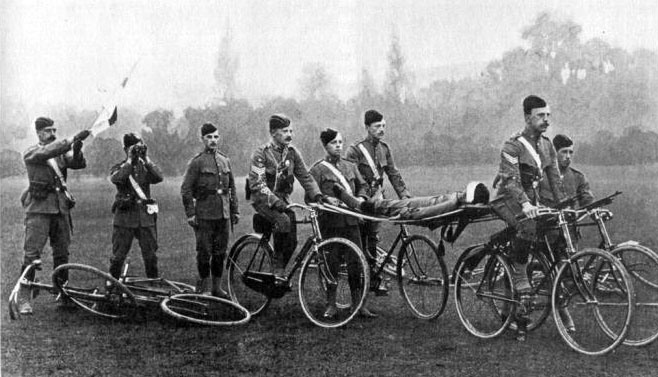
…War has its horrors, and, as provision for the wounded, stretcher-bearers are attached to the rear guard, carrying portable and collapsible stretchers. One cyclist is stationed at each corner of the stretcher upon which their unfortunate comrade is reclining, secured to the saddles of the two leading bearers and upon the handlebars of those in the rear. In cases of emergency, when the staff stretcher is not available, a hurdle or gate is improvised.
– ‘Soldiers on Cycles’
Though horse-drawn carts, cars, trucks, buses and motorcycles played a major role in evacuating wounded soldiers, bicycles were also often used for ambulance duty. Various configurations of bicycles and stretcher were used.
Three or four cycles with a stretcher in the centre was the ideal set up, though enough soldiers might not always be available for such duty. Two bicycles side by side joined by a solid bar was another common rig, this type of bicycle ambulance having been around since the mid-1890s.
But as the casualty rate increased during the war, Medical staff in the field had to improvise to get wounded soldiers back behind the lines. If two cyclists came across a wounded soldier, they could rig up a ‘bicycle ambulance’ as illustrated in the French postcard below:
‘The cyclist battalion – improvised ambulance, comprising two bicycles, two rifles and a sack.’


WW1 FOUR-BICYCLE AMBULANCE
3 Royal Enfield Gents ‘Girder Type’ Roadsters
+ 1914 Royal Triumph Full Roadster

A folded stretcher could easily be carried by one bicycle; when needed three other bicycles could be called into service.


WW1 RED CROSS AMBULANCE SERVICE:
HORSE-CARTS, BICYCLES, MOTORCYCLES, TRUCKS

ROYAL ARMY MEDICAL CORPS: A man’s chances of survival depended on how quickly his wound was treated; modern warfare was now producing vast numbers of casualties requiring treatment at the same time. Medical treated was to start as soon as feasible, and as near to the front line as possible, for this reason Regimental Aid Posts were set up. The Battalion Medical Officer, his orderlies and stretcher-bearers, attended these. In action, the RAP was situated a few metres behind the front line, this could have been in a dugout, in a communication trench, a ruined house, or a deep shell hole. The RMO had the same staff but this became augmented by Regimental Stretcher-Bearers, usually the regimental bandsmen or others. When under pressure, he could be further augmented with bearer teams from a Field Ambulance. (A ‘field ambulance’ was not a vehicle, but a small mobile hospital unit in the most forward position).
The facilities were only sufficient to carry out first aid. The Regimental Aid Post had no holding capacity. Wounded men were to either make their own way or be carried, usually by a member of his own Unit. The object of the exercise was to patch them up and either return them to their duties in the line or pass them back, via hand carriage, wheeled stretchers, or walk if he was able to, to an Advance Dressing station. Those who were in need of further treatment were collected by RAMC Stretcher Bearers from the Advanced Dressing Station and taken to the ADS.
In battle a casualty is to be transported direct to the ADS, however, in the Great War situations necessitated Collecting Posts [CPs] and Relay Posts [RPs] to avoid congestion. This meant there were teams of RAMC stretcher bearers, strung out over miles of ground unpassable by motor or horsed transport, that shuttled between the posts and passing the wounded on to the next team. A ‘carry’ could be anything up to four miles over muddy or shell-pocked ground, either in trenches or above ground. Walking Wounded also had a route between Walking Wounded Collecting Posts [WWCPs]. Where possible in the terrain there were car posts where casualties could be transported by ambulance.*
Horse-drawn ambulances were the most common form of hospital transport, but every available vehicle was pressed into wartime service, to transport the wounded to the Casualty Clearing Stations. These were generally situated abound 15 miles behind the front lines, and were large units, typically with around 50 beds and 150 stretchers to treat 200 wounded. This was the first line of surgery and the furthest forward of nursing staff but treatment could still only be limited. Casualty Clearing Stations were usually grouped in twos or threes and would have worked in relay, that is, one would be closed and treating casualties for evacuation by train or ambulance to the Base Area, whilst the other would be empty and ready to receive new casualties. When this became full it would close, but the first would by now be empty and ready to receive new casualties again. A third would only be treating the sick, but would evacuate to receive battle casualties in an emergency. The holding capacity was about four weeks in order for men to be returned to their units or be transferred by Ambulance Trains or Inland Water Transport to a hospital. The seriousness of many wounds challenged the facilities of the Casualty Clearing Stations and as a result their positions are marked today by large military cemeteries.



The British, French and Americans used motorcycle ambulances. The French machine had a sidecar that seated one patient, while the American Indian Powerplus sidecar outfits (below) fitted either one or two.
The British Red Cross Society used a NUT (Newcatsle-upon-Tyne) 8hp V-Twin with similar configuration to the American machines.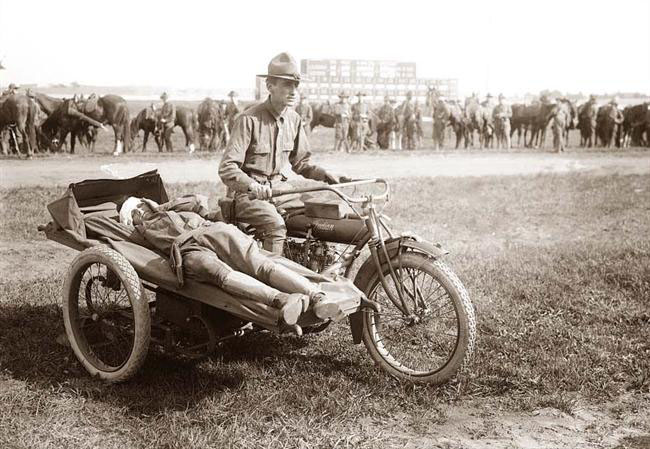

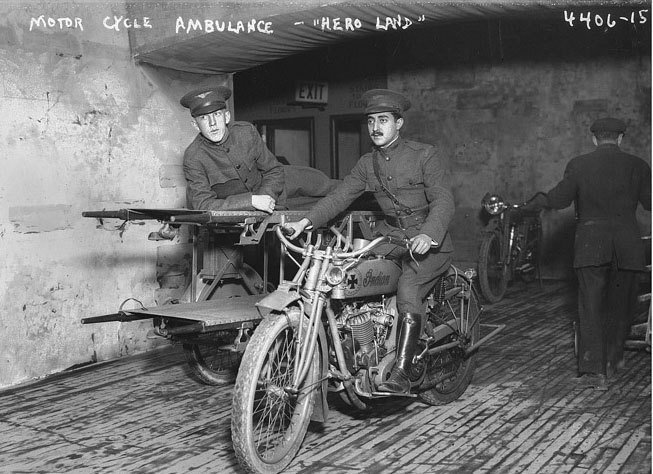
Before the arrival of United States Army, some charitable organizations offered ambulances to the Allied forces. The standard Ford Model T was provided – but without bodywork beyond the cowl. The legend says that the first ten ambulances were created with the wood of the transport cases. Later bodies were produced by the grand carrossier Kellner of Boulogne, near Paris. In 1918 this ambulance became the standard of the US Army in France until the end of the war.









WW1 TWO-BICYCLE AMBULANCE





1909 ROYAL NAVAL & MILITARY TOURNAMENT

The 1909 Royal Naval and Military Tournament displayed an improvised bicycle ambulance using Royal Enfield Girder machines, provided by the 25th (County of London) Cyclist Battalion. The battalion also demonstrated how they used the same machines fitted with solid bars to tow a machine gun.











1894 ALLDAYS & ONIONS PATENT BICYCLE AMBULANCE
In 1894 Alldays patented an Ambulance based upon a handcart fitted with a stretcher covered by a canvas hood and suitable for use in confined areas such as very narrow streets and alleyways. Just one year later the Ambulance had been redesigned using two bicycles side by side, with their frames welded together by transverse tubes about three feet long. Across these tubes was another frame suitable for carrying a stretcher, covered with a detachable canvas hood and for use in similarly confined spaces, but with the added advantage of having two attendants and more rapid speed to takes the patient to hospital. Ambulances like these were adopted by the Birmingham Hospital Saturday Fund who purchased four of these machines in 1895 at a sum of £150.
An 1898 cycle ambulance is illustrated below.
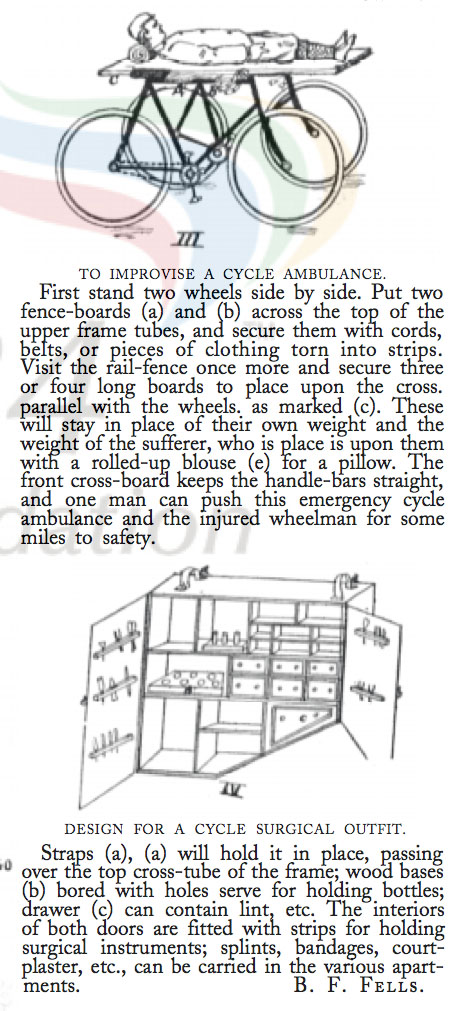

CITY OF LONDON POLICE AMBULANCES

In 1906, ‘The Graphic’ illustrated the above ‘ambulance appliance’ used by the City of London Police. It was a bicycle that folded into an ambulance handcart, similar to the Alldays patent.
However, by the following year, the ‘motor-wagon’ had evolved sufficiently to provide the same police force with London’s first motorised ambulance.


TANDEM AMBULANCE
In America, similar experimentation took place. Robert A Smith reports in ‘A Social History of the Bicycle’ about a bicycle ambulance built in Chicago:
A physician named John T. Hinckley felt that the ambulance service was too slow for emergency cases, and with good reason. At the time, hospitals did not keep horse-drawn ambulances on their premises, and emergency calls were delayed while the hospital contacted the livery stable where the ambulance was housed. Dr Hinckley designed and constructed a bicycle ambulance, consisting of two tandem bicycles fastened side-by-side with a framework that also supported a canvas-covered box in which the patient lay on a stretcher. The machine was more than a passing fancy: ridden by two qualified physicians, it delivered over one hundred patients to hospital in just a few months. Appropriately enough, the first customers brought in on the new speedsters were eight cyclists banged up or exhausted from Chicago’s annual Fourth of July road race. The cycle ambulance was able to make a three-mile run through city traffic in sixteen minutes, a respectable rate of fifteen miles per hour, which a horse-drawn ambulance could not match. Although other doctors and other hospitals were reported interested in the cycle ambulance, its use never seems to have become widespread.
The bicycle was a regular form of transport in Australia in the early years of the 20th century, and the bicycle ambulance was used there too. The 1904 illustration below is from Jim Fitzpatrick’s excellent book ‘Bicycle and the Bush.’ From the chain wheels I can see that they are BSA Fittings bicycles, assembled locally from imported BSA parts.








MODERN BICYCLE AMBULANCES
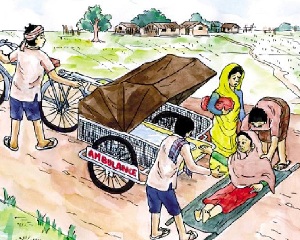
As a footnote, in poor areas of the world, where the roadster bicycle is still used on a regular basis for transportation, the ‘bicycle ambulance’ has taken on a much more practical configuration: a single bicycle towing a stretcher-trailer. The illustration above is from Nepal. The NGO www.practicalaction.org initially assisted communities in south of the country to build trailers for taking goods to market, and then adapted them for ambulance work.
Bicycle ambulances are also used across Africa. The one below is manufactured in Malawi and known as the ‘Care Car.’

Modern Bicycle Ambulance information: Bikes Without Borders
WW1 RAMC info thanks to – http://www.ramc-ww1.com/chain_of_evacuation.php













































